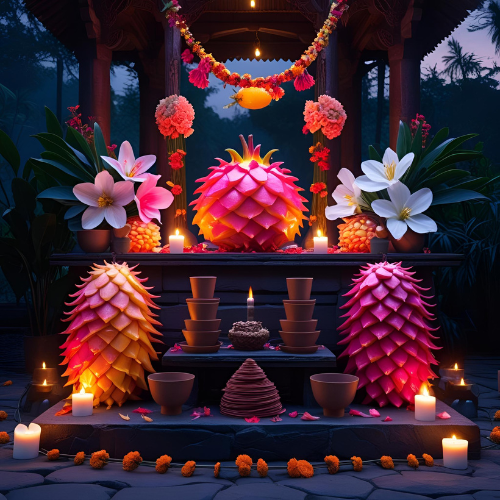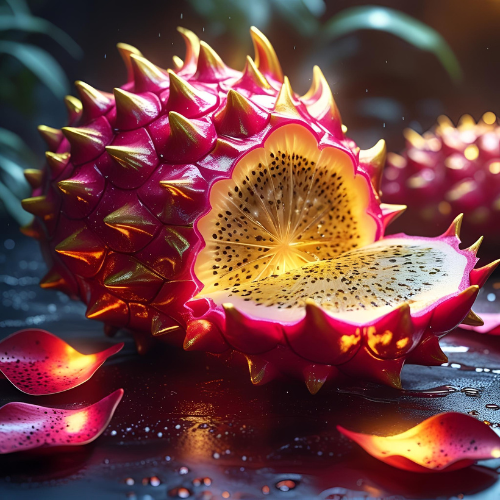The Flarefruit Offering
Each year during Golden Week, the Daeva Empire bursts into color and chaos for the Aeru Festival, a celebration of abundance, indulgence, and the promise of summer. Sharing the first Flarefruit of the season is not only a celebration of summer’s arrival but a reminder of the cycles of planting, tending, and harvest that sustain the people of the Daeva Empire.
Each year, farmers and families begin planting Flarefruit in the cool days of early spring, carefully tending to the creeping vines that love the warm breezes rolling in from the coasts. The vines flower in brilliant shades of white and pale pink under the moonlight, their blossoms opening at night to attract soft-winged pollinators under Azrian’s watch. Locals believe that the moonlight blesses the blossoms, ensuring the fruit will carry clarity and calm dreams when the season turns.
As the weeks warm, the blossoms fall away, and the Flarefruit begins to grow—layers of scales forming in crimson, gold, and deep rose, catching the sunlight and the dew. The fruit needs time to reach its peak sweetness, and families often check their vines at dawn, watching the glow of the scales as they test for ripeness.
The harvest begins in the final weeks of spring, just before Golden Week arrives. It is a joyful, busy time—whole families gather before sunrise to gently cut the heavy fruits from the vines, stacking them in baskets that glow faintly in the morning light. The last of the Flarefruit harvest is always completed by Founding Day, ensuring that every table, altar, and street cart has the freshest fruit for the upcoming banquets and offerings.
Flarefruit’s energy and bright colors align with Naharima’s domains of passion and desire, enhancing connection and intimacy when shared between lovers at festival altars. Its cooling properties offer calm in the face of Alea’s chaos and fear, helping festival-goers steady their nerves before performances and confessions while seeking courage. Its clarity and subtle sweetness invite vivid, guiding dreams under Azrian’s watch, clearing the mind before sleep and warding off restless nights.
On the morning of the Aeru Festival and before the first meal, locals gather to prepare their Flarefruit Offering. They decorate altars, whether at home or at small shrines with offerings of fruit, flowers, cleaned scales and or Flarefruit seeds. What people do with Flarefruit depends on which summer god they wish to honor:
During each sunset of Golden week, locals burn scales, flowers, and incense in small braziers, the smoke rising in soft spirals into the festival night. Children often help decorate pouches stuffed with Flarefruit flowers for ceremonial burning, or weave garlands to wear for luck during Golden Week’s parades and games. Elders share stories of past festivals as they peel Flarefruit with steady hands, teaching younger family members the best way to test for ripeness. Small cups of Flarefruit tonic are passed around to elders, honoring their wisdom while inviting clarity for dreams and restful sleep.
Flarefruit is not just served in sweets and drinks; it often finds its way into the main dishes prepared for the Banquet of the Summer Gods. It is used in vibrant summer salads tossed with citrus and herbs, glazed over roasted meats for a jewel-like sheen, or infused with drinks to bring joy to the communal meal. Serving Flarefruit in these dishes during the ritual feasts symbolizes the gods’ blessings being woven into the nourishment of the people.
The Flarefruit Offering isn’t just about tradition. It’s about pausing to taste the season, about honoring what you desire, facing what you fear, and stepping forward with clear dreams. It’s a celebration that captures the heart of Golden Week—messy, beautiful, indulgent, and alive, just like the people of the Daeva Empire.
The Flarefruit: From Field to Festival
Flarefruit isn’t just a festival fruit—it is a living promise of summer in the Daeva Empire. For many farming families, this harvest is not only a means of livelihood but a moment to reconnect with the land and their ancestors who taught them how to coax the first fruits of summer from the soil.Each year, farmers and families begin planting Flarefruit in the cool days of early spring, carefully tending to the creeping vines that love the warm breezes rolling in from the coasts. The vines flower in brilliant shades of white and pale pink under the moonlight, their blossoms opening at night to attract soft-winged pollinators under Azrian’s watch. Locals believe that the moonlight blesses the blossoms, ensuring the fruit will carry clarity and calm dreams when the season turns.
As the weeks warm, the blossoms fall away, and the Flarefruit begins to grow—layers of scales forming in crimson, gold, and deep rose, catching the sunlight and the dew. The fruit needs time to reach its peak sweetness, and families often check their vines at dawn, watching the glow of the scales as they test for ripeness.
The harvest begins in the final weeks of spring, just before Golden Week arrives. It is a joyful, busy time—whole families gather before sunrise to gently cut the heavy fruits from the vines, stacking them in baskets that glow faintly in the morning light. The last of the Flarefruit harvest is always completed by Founding Day, ensuring that every table, altar, and street cart has the freshest fruit for the upcoming banquets and offerings.
Symbolism
At its core, the Flarefruit Offering is an act of gratitude to the earth, the labor of farmers, and the blessings of the summer gods, acknowledging that every bite of Flarefruit is a gift of the land. Harvested at the turning point between spring’s promise and summer’s warmth, Flarefruit becomes a living symbol of hope, vitality, and abundance during Golden Week. Its vibrant hues and refreshing sweetness make it the crown jewel of the Aeru Festival, featured in every feast and shared among families, lovers, and friends.Flarefruit’s energy and bright colors align with Naharima’s domains of passion and desire, enhancing connection and intimacy when shared between lovers at festival altars. Its cooling properties offer calm in the face of Alea’s chaos and fear, helping festival-goers steady their nerves before performances and confessions while seeking courage. Its clarity and subtle sweetness invite vivid, guiding dreams under Azrian’s watch, clearing the mind before sleep and warding off restless nights.
Rituals
Starting on Citizen’s Day, the streets come alive with parades, street fairs, and talent shows. Throughout the city, food stalls prepare Flarefruit in every form imaginable: chilled creams, refreshing tonics, icy sorbets, and cocktails that glitter like the festival lights, blending tradition with the empire’s playful creativity.On the morning of the Aeru Festival and before the first meal, locals gather to prepare their Flarefruit Offering. They decorate altars, whether at home or at small shrines with offerings of fruit, flowers, cleaned scales and or Flarefruit seeds. What people do with Flarefruit depends on which summer god they wish to honor:
Naharima:
Lovers share chilled Flarefruit slices by the altar, feeding each other while draping Flarefruit flower garlands to call in passion and blessings for the year ahead.Alea:
Participants place Flarefruit scales around Alea’s altar, sipping Flarefruit wine in silence or while whispering confessions of fear and regrets, embracing chaos and asking for courage.Azrian:
Flarefruit seeds are offered on Azrian’s altar, and Flarefruit creams or tonics are shared before sleep, asking for vivid, guiding dreams and peaceful nights.
During each sunset of Golden week, locals burn scales, flowers, and incense in small braziers, the smoke rising in soft spirals into the festival night. Children often help decorate pouches stuffed with Flarefruit flowers for ceremonial burning, or weave garlands to wear for luck during Golden Week’s parades and games. Elders share stories of past festivals as they peel Flarefruit with steady hands, teaching younger family members the best way to test for ripeness. Small cups of Flarefruit tonic are passed around to elders, honoring their wisdom while inviting clarity for dreams and restful sleep.
Flarefruit is not just served in sweets and drinks; it often finds its way into the main dishes prepared for the Banquet of the Summer Gods. It is used in vibrant summer salads tossed with citrus and herbs, glazed over roasted meats for a jewel-like sheen, or infused with drinks to bring joy to the communal meal. Serving Flarefruit in these dishes during the ritual feasts symbolizes the gods’ blessings being woven into the nourishment of the people.
The Flarefruit Offering isn’t just about tradition. It’s about pausing to taste the season, about honoring what you desire, facing what you fear, and stepping forward with clear dreams. It’s a celebration that captures the heart of Golden Week—messy, beautiful, indulgent, and alive, just like the people of the Daeva Empire.







Comments